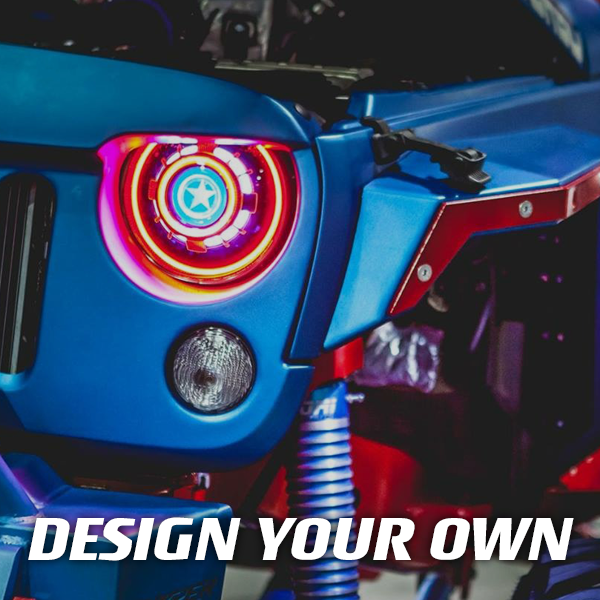Blinded by Bright Headlights: When They Become a Hazard
Modern advancements in automotive technology have significantly improved vehicle safety and performance. One of the notable improvements is the enhancement of headlight brightness.
While brighter headlights undoubtedly enhance driver visibility, they can also pose a significant hazard when their intense glare blinds oncoming traffic or nearby pedestrians. Explore how and why it can become a blinding hazard and what can be done to mitigate these risks.
Headlights have come a long way since their inception. Initially, cars were equipped with dim acetylene lamps, which barely illuminated the road ahead. Over time, these were replaced by halogen lamps and, more recently, by high-intensity discharge (HID) and light-emitting diode (LED) headlights. These modern headlights are not only brighter but also more energy-efficient and long-lasting.
Why Am I Being Blinded By Bright Headlights?
Headlights can blind you due to excessive brightness, improper alignment, or high beam usage. Modern headlights, especially LED and HID types, can be much brighter than traditional halogen bulbs, causing glare. Misaligned headlights or drivers failing to switch from high to low beams can also contribute to the problem, reducing visibility and increasing the risk of accidents.
Another significant danger of these headlights is that many drivers selfishly leave them turned on even when parked. This poses a particular hazard for pedestrians, as the dazzling headlights make it difficult for oncoming drivers to see people walking beyond the intense light.
Factors Contributing to Blinding Bright Headlights
Intensity and Direction of Light:
Bright headlights are designed to project intense light far down the road. However, if the headlights are misaligned, they can shine directly into the eyes of oncoming drivers, causing temporary blindness and disorientation.
Improper Installation and Lack of Education:
Many drivers upgrade their headlights without proper research or knowledge. Installing LED or HID bulbs in housings designed for halogen bulbs or neglecting to adjust the beam alignment, can lead to increased glare and improper light distribution.
Beam Pattern:
The beam pattern of headlights determines how the light is distributed. Poorly designed or improperly adjusted beam patterns can scatter light in unwanted directions, increasing glare for other road users.
Color Temperature:
Modern headlights often have a higher color temperature, emitting a bluish-white light. This type of light can be more glaring than traditional halogen bulbs' warmer, yellowish light. The higher the color temperature, the more likely it is to cause discomfort and glare.
Height of the Vehicle:
The height of a vehicle plays a crucial role in the impact of headlight glare. Trucks and SUVs, with their elevated headlight positions, can cause more glare to drivers in lower-sitting cars.
Inconsiderate Usage:
Another significant danger is that many drivers selfishly leave their headlights turned on even when parked. This poses a particular hazard for pedestrians, as the dazzling headlights make it difficult for oncoming drivers to see people walking beyond the intense light.
The Impact of Bright Headlights
Most modern headlights are LED or HID, which utilize a more focused beam. While they are brighter, this increased focus can intensify the light.
Many people upgrade their halogen headlights to LED without proper research. It's important to note that housings designed for halogen bulbs differ from those for LED or HID bulbs. Simply installing an LED or HID bulb into a halogen housing is not advisable. Only two-sided LED bulbs will produce the correct light pattern in housings designed for standard halogen bulbs.
Even with this consideration, adjustments are necessary to accommodate the brighter, more focused light. Some housings are not suitable for LED or HID lights. Additionally, vehicles equipped with LED lights require specific adjustments to compensate for the more focused beam.Blinding headlights can have severe consequences, including:
- Temporary Blindness: Sudden exposure to bright lights can cause temporary blindness, making it difficult for drivers to see the road, lane markings, or other vehicles. This can lead to accidents, especially on narrow or winding roads.
- Reduced Reaction Time: Glare from oncoming headlights can reduce a driver's reaction time, making it harder to respond quickly to changes in traffic conditions or obstacles on the road.
- Increased Eye Strain: Prolonged exposure to intense light can cause eye strain and fatigue, reducing overall driving performance and alertness.
What Should You Do If You're Blinded By The Headlights Of Another Driver?
If the bright headlights of another driver blind you, follow these steps to ensure your safety:
- Avert Your Eyes: Look slightly to the right side of the road and use the lane markings as a guide to stay on course.
- Reduce Speed: Gradually slow down to give yourself more time to react.
- Maintain Distance: Keep a safe distance from the car in front of you to avoid sudden stops or collisions.
- Use Your Rearview Mirror: Adjust your rearview mirror to the night setting to reduce glare from headlights behind you.
- Avoid Staring at the Lights: Do not look directly at the oncoming headlights as this will increase the glare and affect your vision.
- Use Your Peripheral Vision: Use your peripheral vision to navigate and maintain awareness of the road.
- Blink Frequently: Blinking can help reduce the glare and moisten your eyes.
- Keep Windows Clean: Ensure your windshield and windows are clean to reduce glare and improve visibility.
Stay calm and focused until the other vehicle passes and your vision returns to normal.
Ensuring Safe Headlight Brightness on the Road
To ensure that headlight brightness does not become a hazard, several measures can be taken:
- Regulation and Standards: Governments and automotive organizations must establish and enforce headlight brightness, beam pattern, and alignment regulations. Ensuring compliance with these standards can help reduce the incidence of blinding headlights.
- Proper Headlight Alignment: Regularly checking and adjusting headlight alignment can ensure that the beam pattern is correctly directed onto the road and not into the eyes of other road users.
- Adaptive Headlight Systems: Modern vehicles are increasingly equipped with adaptive headlight systems that adjust the intensity and direction of the light based on driving conditions and the presence of other vehicles. These systems can help minimize glare and improve overall safety.
- Awareness and Education: Drivers should be educated about the importance of proper headlight use, including the appropriate use of high beams and maintaining their headlight systems.
Conclusion
While bright headlights are essential for improving visibility and safety, balancing their benefits with potential hazards is crucial. By understanding the factors contributing to blinding headlights and implementing measures to mitigate these risks, we can ensure that our roads remain safe for all users. High-quality headlight options at HIDprojectors offer enhanced visibility with properly focused beams, reducing glare and improving overall safety. As technology evolves, ongoing research and innovation will play a key role in developing headlight systems that maximize safety without compromising the comfort and well-being of drivers and pedestrians.











